Criminal Law Report: Analysis of Intention, Motive, and Negligence
VerifiedAdded on 2020/06/04
|10
|3019
|26
Report
AI Summary
This criminal law report delves into key concepts such as intention, motive, and negligence within the framework of UK criminal law. The report examines the significance of intention and motive in establishing criminal liability, differentiating between direct and oblique intent. It explores relevant case law, including DPP v Smith, illustrating the application of legal principles. The report further analyzes a scenario involving negligence at a theme park, focusing on the duty of care, breach of duty, and the resulting damages. It provides advice to a defendant, Sophia, regarding her potential liability for the injuries sustained by Ethan, emphasizing the importance of establishing negligence and the elements of assault. The report also discusses the differences between cognizable and non-cognizable offenses, wrongful acts, and the relevance of mens rea in criminal proceedings, providing a detailed overview of legal terms and their application.
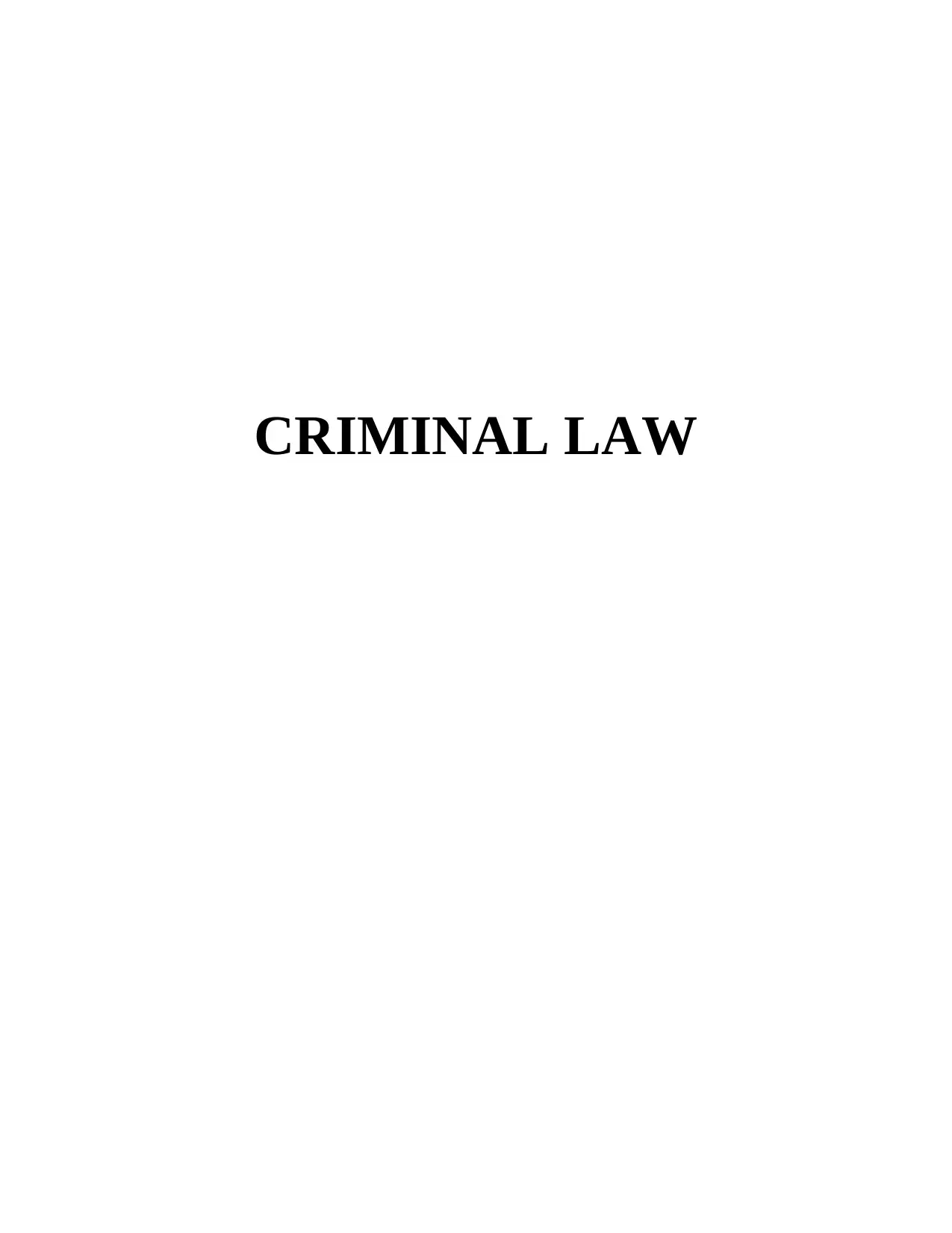
CRIMINAL LAW
Paraphrase This Document
Need a fresh take? Get an instant paraphrase of this document with our AI Paraphraser
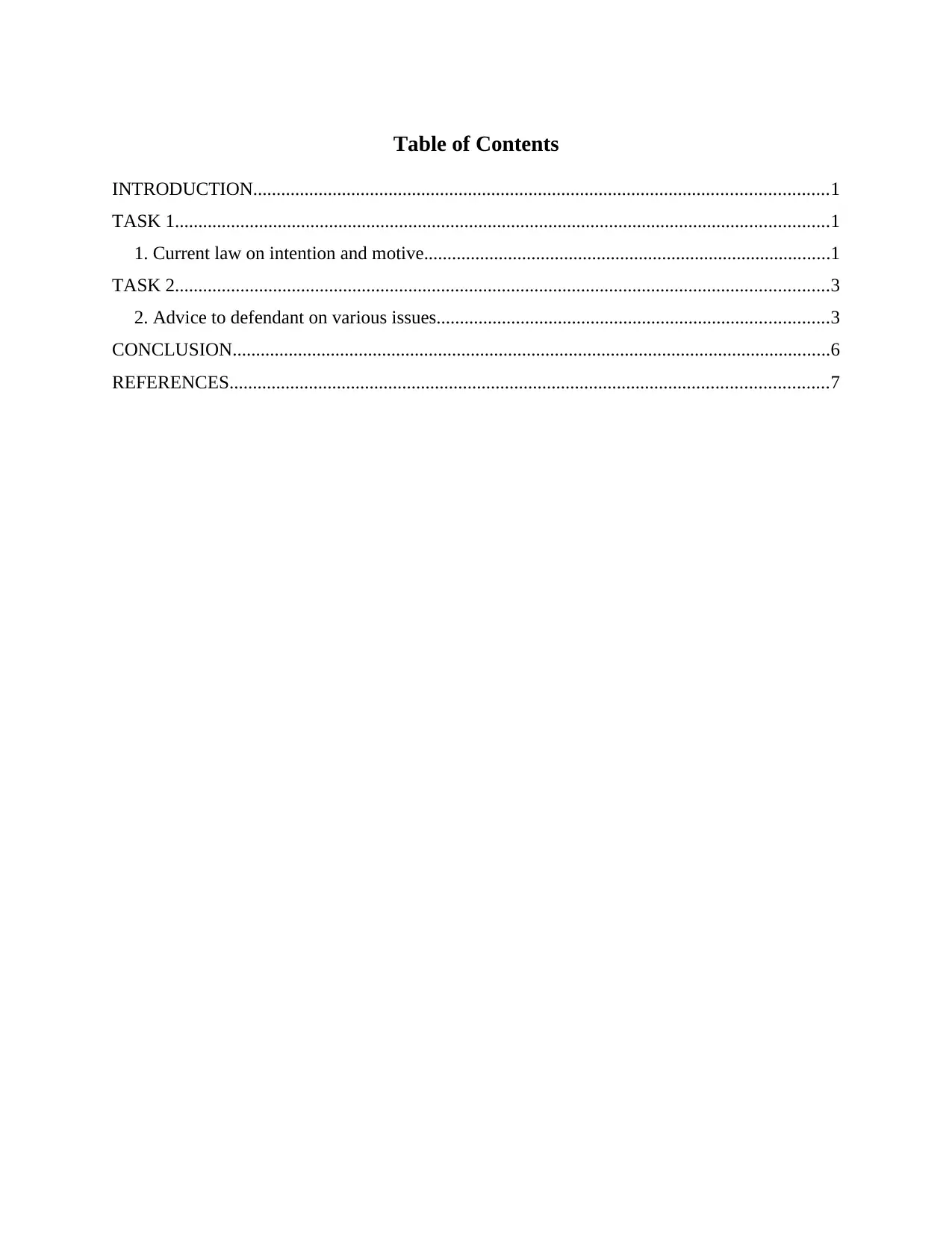
Table of Contents
INTRODUCTION...........................................................................................................................1
TASK 1............................................................................................................................................1
1. Current law on intention and motive.......................................................................................1
TASK 2............................................................................................................................................3
2. Advice to defendant on various issues....................................................................................3
CONCLUSION................................................................................................................................6
REFERENCES................................................................................................................................7
INTRODUCTION...........................................................................................................................1
TASK 1............................................................................................................................................1
1. Current law on intention and motive.......................................................................................1
TASK 2............................................................................................................................................3
2. Advice to defendant on various issues....................................................................................3
CONCLUSION................................................................................................................................6
REFERENCES................................................................................................................................7

⊘ This is a preview!⊘
Do you want full access?
Subscribe today to unlock all pages.

Trusted by 1+ million students worldwide
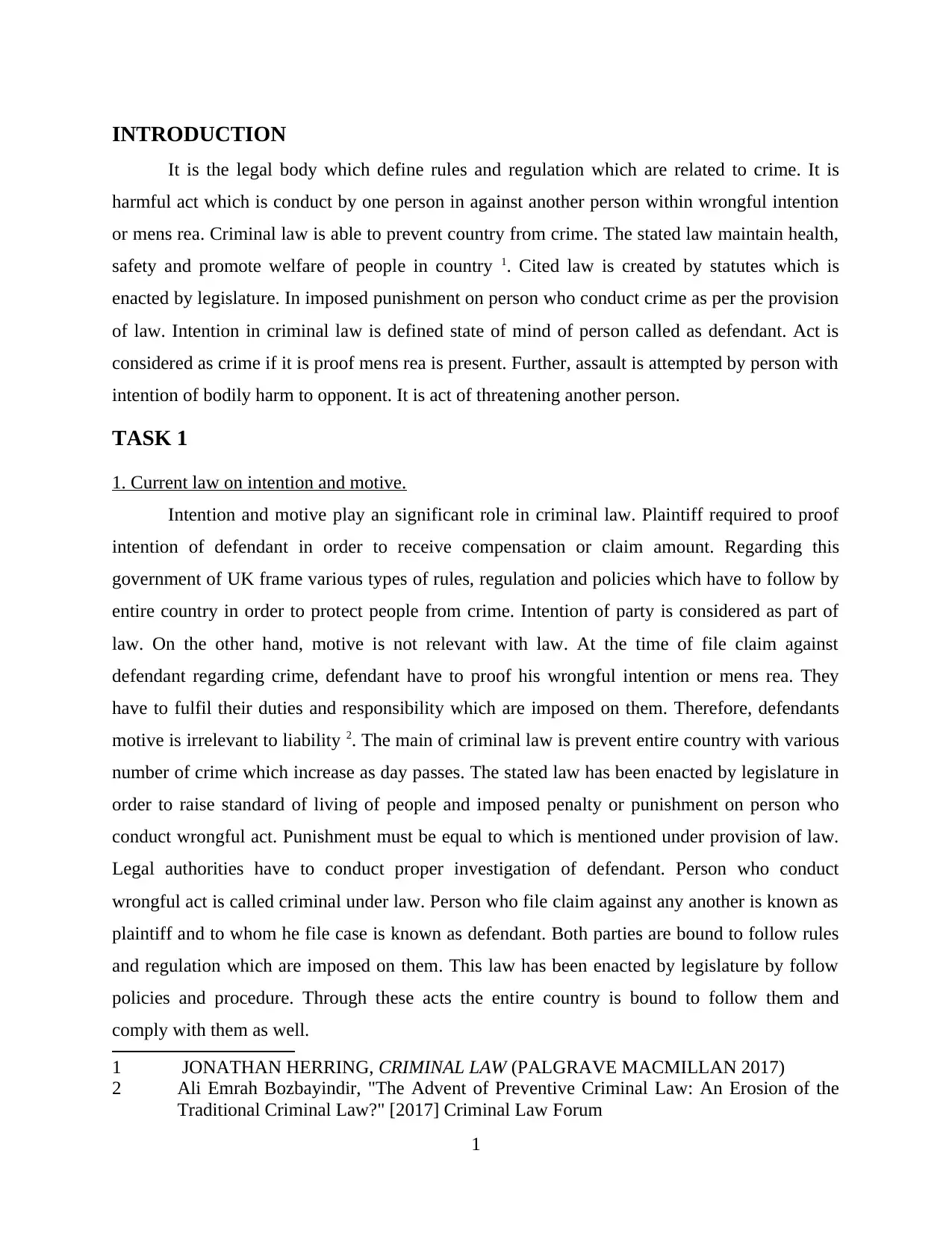
INTRODUCTION
It is the legal body which define rules and regulation which are related to crime. It is
harmful act which is conduct by one person in against another person within wrongful intention
or mens rea. Criminal law is able to prevent country from crime. The stated law maintain health,
safety and promote welfare of people in country 1. Cited law is created by statutes which is
enacted by legislature. In imposed punishment on person who conduct crime as per the provision
of law. Intention in criminal law is defined state of mind of person called as defendant. Act is
considered as crime if it is proof mens rea is present. Further, assault is attempted by person with
intention of bodily harm to opponent. It is act of threatening another person.
TASK 1
1. Current law on intention and motive.
Intention and motive play an significant role in criminal law. Plaintiff required to proof
intention of defendant in order to receive compensation or claim amount. Regarding this
government of UK frame various types of rules, regulation and policies which have to follow by
entire country in order to protect people from crime. Intention of party is considered as part of
law. On the other hand, motive is not relevant with law. At the time of file claim against
defendant regarding crime, defendant have to proof his wrongful intention or mens rea. They
have to fulfil their duties and responsibility which are imposed on them. Therefore, defendants
motive is irrelevant to liability 2. The main of criminal law is prevent entire country with various
number of crime which increase as day passes. The stated law has been enacted by legislature in
order to raise standard of living of people and imposed penalty or punishment on person who
conduct wrongful act. Punishment must be equal to which is mentioned under provision of law.
Legal authorities have to conduct proper investigation of defendant. Person who conduct
wrongful act is called criminal under law. Person who file claim against any another is known as
plaintiff and to whom he file case is known as defendant. Both parties are bound to follow rules
and regulation which are imposed on them. This law has been enacted by legislature by follow
policies and procedure. Through these acts the entire country is bound to follow them and
comply with them as well.
1 JONATHAN HERRING, CRIMINAL LAW (PALGRAVE MACMILLAN 2017)
2 Ali Emrah Bozbayindir, "The Advent of Preventive Criminal Law: An Erosion of the
Traditional Criminal Law?" [2017] Criminal Law Forum
1
It is the legal body which define rules and regulation which are related to crime. It is
harmful act which is conduct by one person in against another person within wrongful intention
or mens rea. Criminal law is able to prevent country from crime. The stated law maintain health,
safety and promote welfare of people in country 1. Cited law is created by statutes which is
enacted by legislature. In imposed punishment on person who conduct crime as per the provision
of law. Intention in criminal law is defined state of mind of person called as defendant. Act is
considered as crime if it is proof mens rea is present. Further, assault is attempted by person with
intention of bodily harm to opponent. It is act of threatening another person.
TASK 1
1. Current law on intention and motive.
Intention and motive play an significant role in criminal law. Plaintiff required to proof
intention of defendant in order to receive compensation or claim amount. Regarding this
government of UK frame various types of rules, regulation and policies which have to follow by
entire country in order to protect people from crime. Intention of party is considered as part of
law. On the other hand, motive is not relevant with law. At the time of file claim against
defendant regarding crime, defendant have to proof his wrongful intention or mens rea. They
have to fulfil their duties and responsibility which are imposed on them. Therefore, defendants
motive is irrelevant to liability 2. The main of criminal law is prevent entire country with various
number of crime which increase as day passes. The stated law has been enacted by legislature in
order to raise standard of living of people and imposed penalty or punishment on person who
conduct wrongful act. Punishment must be equal to which is mentioned under provision of law.
Legal authorities have to conduct proper investigation of defendant. Person who conduct
wrongful act is called criminal under law. Person who file claim against any another is known as
plaintiff and to whom he file case is known as defendant. Both parties are bound to follow rules
and regulation which are imposed on them. This law has been enacted by legislature by follow
policies and procedure. Through these acts the entire country is bound to follow them and
comply with them as well.
1 JONATHAN HERRING, CRIMINAL LAW (PALGRAVE MACMILLAN 2017)
2 Ali Emrah Bozbayindir, "The Advent of Preventive Criminal Law: An Erosion of the
Traditional Criminal Law?" [2017] Criminal Law Forum
1
Paraphrase This Document
Need a fresh take? Get an instant paraphrase of this document with our AI Paraphraser
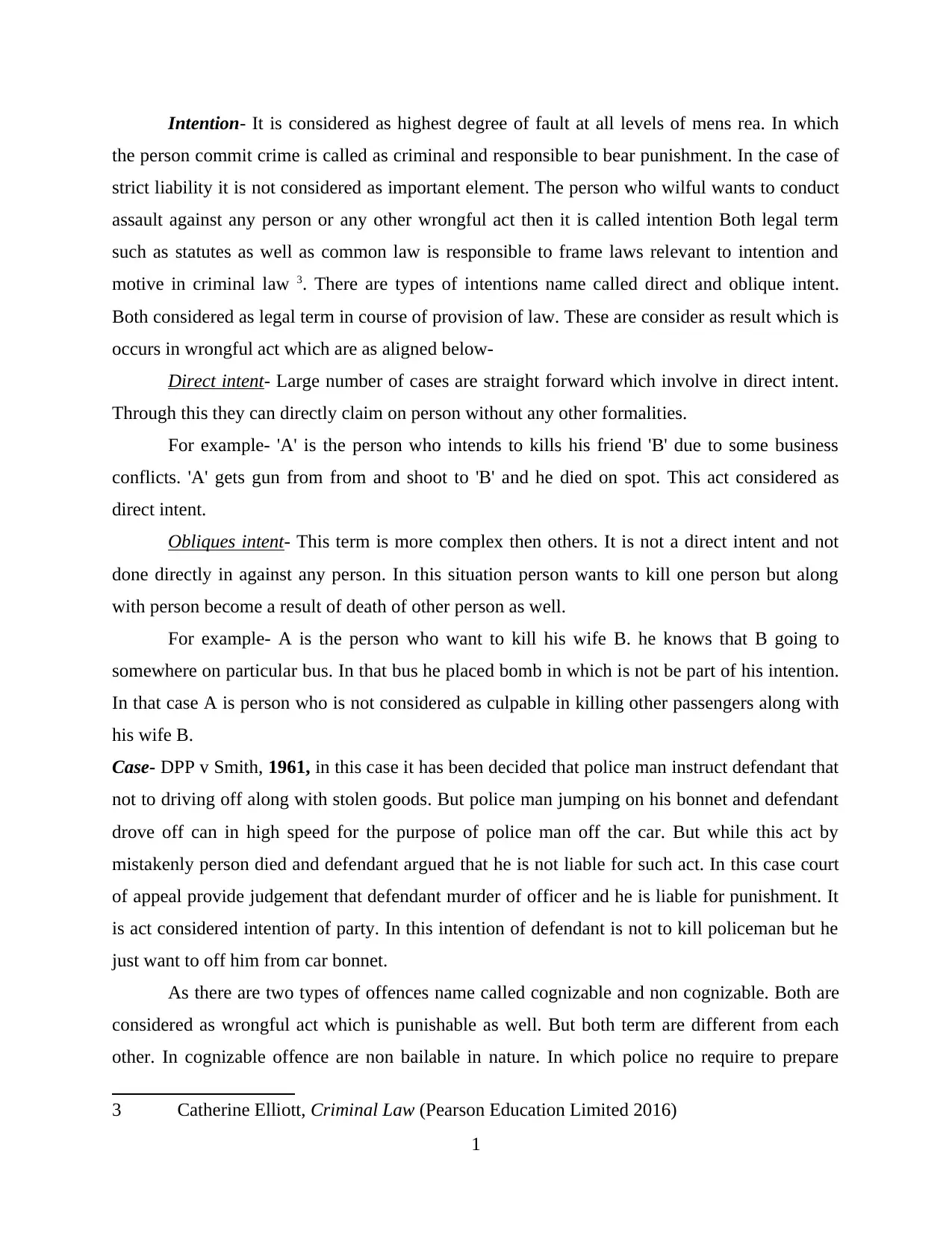
Intention- It is considered as highest degree of fault at all levels of mens rea. In which
the person commit crime is called as criminal and responsible to bear punishment. In the case of
strict liability it is not considered as important element. The person who wilful wants to conduct
assault against any person or any other wrongful act then it is called intention Both legal term
such as statutes as well as common law is responsible to frame laws relevant to intention and
motive in criminal law 3. There are types of intentions name called direct and oblique intent.
Both considered as legal term in course of provision of law. These are consider as result which is
occurs in wrongful act which are as aligned below-
Direct intent- Large number of cases are straight forward which involve in direct intent.
Through this they can directly claim on person without any other formalities.
For example- 'A' is the person who intends to kills his friend 'B' due to some business
conflicts. 'A' gets gun from from and shoot to 'B' and he died on spot. This act considered as
direct intent.
Obliques intent- This term is more complex then others. It is not a direct intent and not
done directly in against any person. In this situation person wants to kill one person but along
with person become a result of death of other person as well.
For example- A is the person who want to kill his wife B. he knows that B going to
somewhere on particular bus. In that bus he placed bomb in which is not be part of his intention.
In that case A is person who is not considered as culpable in killing other passengers along with
his wife B.
Case- DPP v Smith, 1961, in this case it has been decided that police man instruct defendant that
not to driving off along with stolen goods. But police man jumping on his bonnet and defendant
drove off can in high speed for the purpose of police man off the car. But while this act by
mistakenly person died and defendant argued that he is not liable for such act. In this case court
of appeal provide judgement that defendant murder of officer and he is liable for punishment. It
is act considered intention of party. In this intention of defendant is not to kill policeman but he
just want to off him from car bonnet.
As there are two types of offences name called cognizable and non cognizable. Both are
considered as wrongful act which is punishable as well. But both term are different from each
other. In cognizable offence are non bailable in nature. In which police no require to prepare
3 Catherine Elliott, Criminal Law (Pearson Education Limited 2016)
1
the person commit crime is called as criminal and responsible to bear punishment. In the case of
strict liability it is not considered as important element. The person who wilful wants to conduct
assault against any person or any other wrongful act then it is called intention Both legal term
such as statutes as well as common law is responsible to frame laws relevant to intention and
motive in criminal law 3. There are types of intentions name called direct and oblique intent.
Both considered as legal term in course of provision of law. These are consider as result which is
occurs in wrongful act which are as aligned below-
Direct intent- Large number of cases are straight forward which involve in direct intent.
Through this they can directly claim on person without any other formalities.
For example- 'A' is the person who intends to kills his friend 'B' due to some business
conflicts. 'A' gets gun from from and shoot to 'B' and he died on spot. This act considered as
direct intent.
Obliques intent- This term is more complex then others. It is not a direct intent and not
done directly in against any person. In this situation person wants to kill one person but along
with person become a result of death of other person as well.
For example- A is the person who want to kill his wife B. he knows that B going to
somewhere on particular bus. In that bus he placed bomb in which is not be part of his intention.
In that case A is person who is not considered as culpable in killing other passengers along with
his wife B.
Case- DPP v Smith, 1961, in this case it has been decided that police man instruct defendant that
not to driving off along with stolen goods. But police man jumping on his bonnet and defendant
drove off can in high speed for the purpose of police man off the car. But while this act by
mistakenly person died and defendant argued that he is not liable for such act. In this case court
of appeal provide judgement that defendant murder of officer and he is liable for punishment. It
is act considered intention of party. In this intention of defendant is not to kill policeman but he
just want to off him from car bonnet.
As there are two types of offences name called cognizable and non cognizable. Both are
considered as wrongful act which is punishable as well. But both term are different from each
other. In cognizable offence are non bailable in nature. In which police no require to prepare
3 Catherine Elliott, Criminal Law (Pearson Education Limited 2016)
1
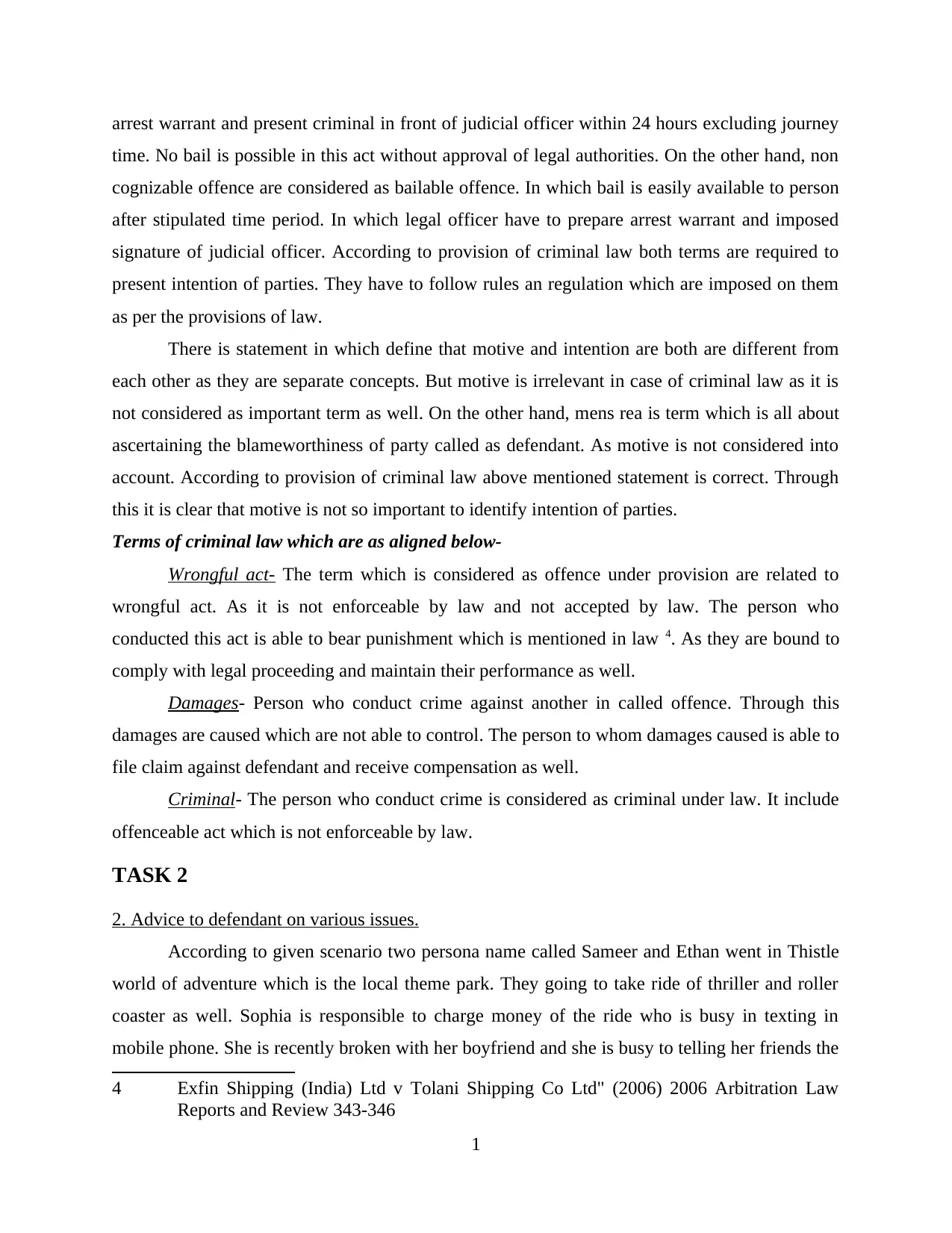
arrest warrant and present criminal in front of judicial officer within 24 hours excluding journey
time. No bail is possible in this act without approval of legal authorities. On the other hand, non
cognizable offence are considered as bailable offence. In which bail is easily available to person
after stipulated time period. In which legal officer have to prepare arrest warrant and imposed
signature of judicial officer. According to provision of criminal law both terms are required to
present intention of parties. They have to follow rules an regulation which are imposed on them
as per the provisions of law.
There is statement in which define that motive and intention are both are different from
each other as they are separate concepts. But motive is irrelevant in case of criminal law as it is
not considered as important term as well. On the other hand, mens rea is term which is all about
ascertaining the blameworthiness of party called as defendant. As motive is not considered into
account. According to provision of criminal law above mentioned statement is correct. Through
this it is clear that motive is not so important to identify intention of parties.
Terms of criminal law which are as aligned below-
Wrongful act- The term which is considered as offence under provision are related to
wrongful act. As it is not enforceable by law and not accepted by law. The person who
conducted this act is able to bear punishment which is mentioned in law 4. As they are bound to
comply with legal proceeding and maintain their performance as well.
Damages- Person who conduct crime against another in called offence. Through this
damages are caused which are not able to control. The person to whom damages caused is able to
file claim against defendant and receive compensation as well.
Criminal- The person who conduct crime is considered as criminal under law. It include
offenceable act which is not enforceable by law.
TASK 2
2. Advice to defendant on various issues.
According to given scenario two persona name called Sameer and Ethan went in Thistle
world of adventure which is the local theme park. They going to take ride of thriller and roller
coaster as well. Sophia is responsible to charge money of the ride who is busy in texting in
mobile phone. She is recently broken with her boyfriend and she is busy to telling her friends the
4 Exfin Shipping (India) Ltd v Tolani Shipping Co Ltd" (2006) 2006 Arbitration Law
Reports and Review 343-346
1
time. No bail is possible in this act without approval of legal authorities. On the other hand, non
cognizable offence are considered as bailable offence. In which bail is easily available to person
after stipulated time period. In which legal officer have to prepare arrest warrant and imposed
signature of judicial officer. According to provision of criminal law both terms are required to
present intention of parties. They have to follow rules an regulation which are imposed on them
as per the provisions of law.
There is statement in which define that motive and intention are both are different from
each other as they are separate concepts. But motive is irrelevant in case of criminal law as it is
not considered as important term as well. On the other hand, mens rea is term which is all about
ascertaining the blameworthiness of party called as defendant. As motive is not considered into
account. According to provision of criminal law above mentioned statement is correct. Through
this it is clear that motive is not so important to identify intention of parties.
Terms of criminal law which are as aligned below-
Wrongful act- The term which is considered as offence under provision are related to
wrongful act. As it is not enforceable by law and not accepted by law. The person who
conducted this act is able to bear punishment which is mentioned in law 4. As they are bound to
comply with legal proceeding and maintain their performance as well.
Damages- Person who conduct crime against another in called offence. Through this
damages are caused which are not able to control. The person to whom damages caused is able to
file claim against defendant and receive compensation as well.
Criminal- The person who conduct crime is considered as criminal under law. It include
offenceable act which is not enforceable by law.
TASK 2
2. Advice to defendant on various issues.
According to given scenario two persona name called Sameer and Ethan went in Thistle
world of adventure which is the local theme park. They going to take ride of thriller and roller
coaster as well. Sophia is responsible to charge money of the ride who is busy in texting in
mobile phone. She is recently broken with her boyfriend and she is busy to telling her friends the
4 Exfin Shipping (India) Ltd v Tolani Shipping Co Ltd" (2006) 2006 Arbitration Law
Reports and Review 343-346
1
⊘ This is a preview!⊘
Do you want full access?
Subscribe today to unlock all pages.

Trusted by 1+ million students worldwide
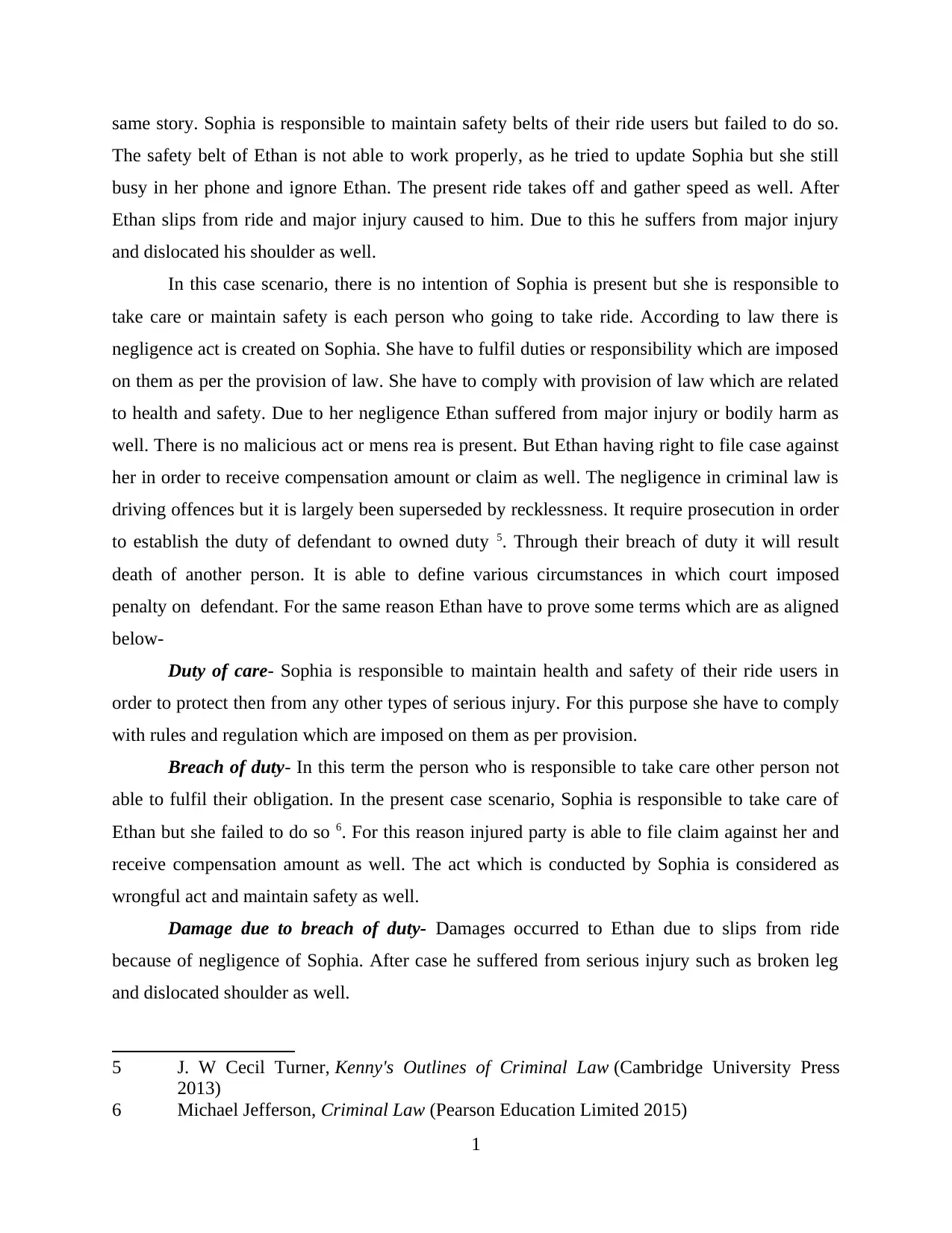
same story. Sophia is responsible to maintain safety belts of their ride users but failed to do so.
The safety belt of Ethan is not able to work properly, as he tried to update Sophia but she still
busy in her phone and ignore Ethan. The present ride takes off and gather speed as well. After
Ethan slips from ride and major injury caused to him. Due to this he suffers from major injury
and dislocated his shoulder as well.
In this case scenario, there is no intention of Sophia is present but she is responsible to
take care or maintain safety is each person who going to take ride. According to law there is
negligence act is created on Sophia. She have to fulfil duties or responsibility which are imposed
on them as per the provision of law. She have to comply with provision of law which are related
to health and safety. Due to her negligence Ethan suffered from major injury or bodily harm as
well. There is no malicious act or mens rea is present. But Ethan having right to file case against
her in order to receive compensation amount or claim as well. The negligence in criminal law is
driving offences but it is largely been superseded by recklessness. It require prosecution in order
to establish the duty of defendant to owned duty 5. Through their breach of duty it will result
death of another person. It is able to define various circumstances in which court imposed
penalty on defendant. For the same reason Ethan have to prove some terms which are as aligned
below-
Duty of care- Sophia is responsible to maintain health and safety of their ride users in
order to protect then from any other types of serious injury. For this purpose she have to comply
with rules and regulation which are imposed on them as per provision.
Breach of duty- In this term the person who is responsible to take care other person not
able to fulfil their obligation. In the present case scenario, Sophia is responsible to take care of
Ethan but she failed to do so 6. For this reason injured party is able to file claim against her and
receive compensation amount as well. The act which is conducted by Sophia is considered as
wrongful act and maintain safety as well.
Damage due to breach of duty- Damages occurred to Ethan due to slips from ride
because of negligence of Sophia. After case he suffered from serious injury such as broken leg
and dislocated shoulder as well.
5 J. W Cecil Turner, Kenny's Outlines of Criminal Law (Cambridge University Press
2013)
6 Michael Jefferson, Criminal Law (Pearson Education Limited 2015)
1
The safety belt of Ethan is not able to work properly, as he tried to update Sophia but she still
busy in her phone and ignore Ethan. The present ride takes off and gather speed as well. After
Ethan slips from ride and major injury caused to him. Due to this he suffers from major injury
and dislocated his shoulder as well.
In this case scenario, there is no intention of Sophia is present but she is responsible to
take care or maintain safety is each person who going to take ride. According to law there is
negligence act is created on Sophia. She have to fulfil duties or responsibility which are imposed
on them as per the provision of law. She have to comply with provision of law which are related
to health and safety. Due to her negligence Ethan suffered from major injury or bodily harm as
well. There is no malicious act or mens rea is present. But Ethan having right to file case against
her in order to receive compensation amount or claim as well. The negligence in criminal law is
driving offences but it is largely been superseded by recklessness. It require prosecution in order
to establish the duty of defendant to owned duty 5. Through their breach of duty it will result
death of another person. It is able to define various circumstances in which court imposed
penalty on defendant. For the same reason Ethan have to prove some terms which are as aligned
below-
Duty of care- Sophia is responsible to maintain health and safety of their ride users in
order to protect then from any other types of serious injury. For this purpose she have to comply
with rules and regulation which are imposed on them as per provision.
Breach of duty- In this term the person who is responsible to take care other person not
able to fulfil their obligation. In the present case scenario, Sophia is responsible to take care of
Ethan but she failed to do so 6. For this reason injured party is able to file claim against her and
receive compensation amount as well. The act which is conducted by Sophia is considered as
wrongful act and maintain safety as well.
Damage due to breach of duty- Damages occurred to Ethan due to slips from ride
because of negligence of Sophia. After case he suffered from serious injury such as broken leg
and dislocated shoulder as well.
5 J. W Cecil Turner, Kenny's Outlines of Criminal Law (Cambridge University Press
2013)
6 Michael Jefferson, Criminal Law (Pearson Education Limited 2015)
1
Paraphrase This Document
Need a fresh take? Get an instant paraphrase of this document with our AI Paraphraser
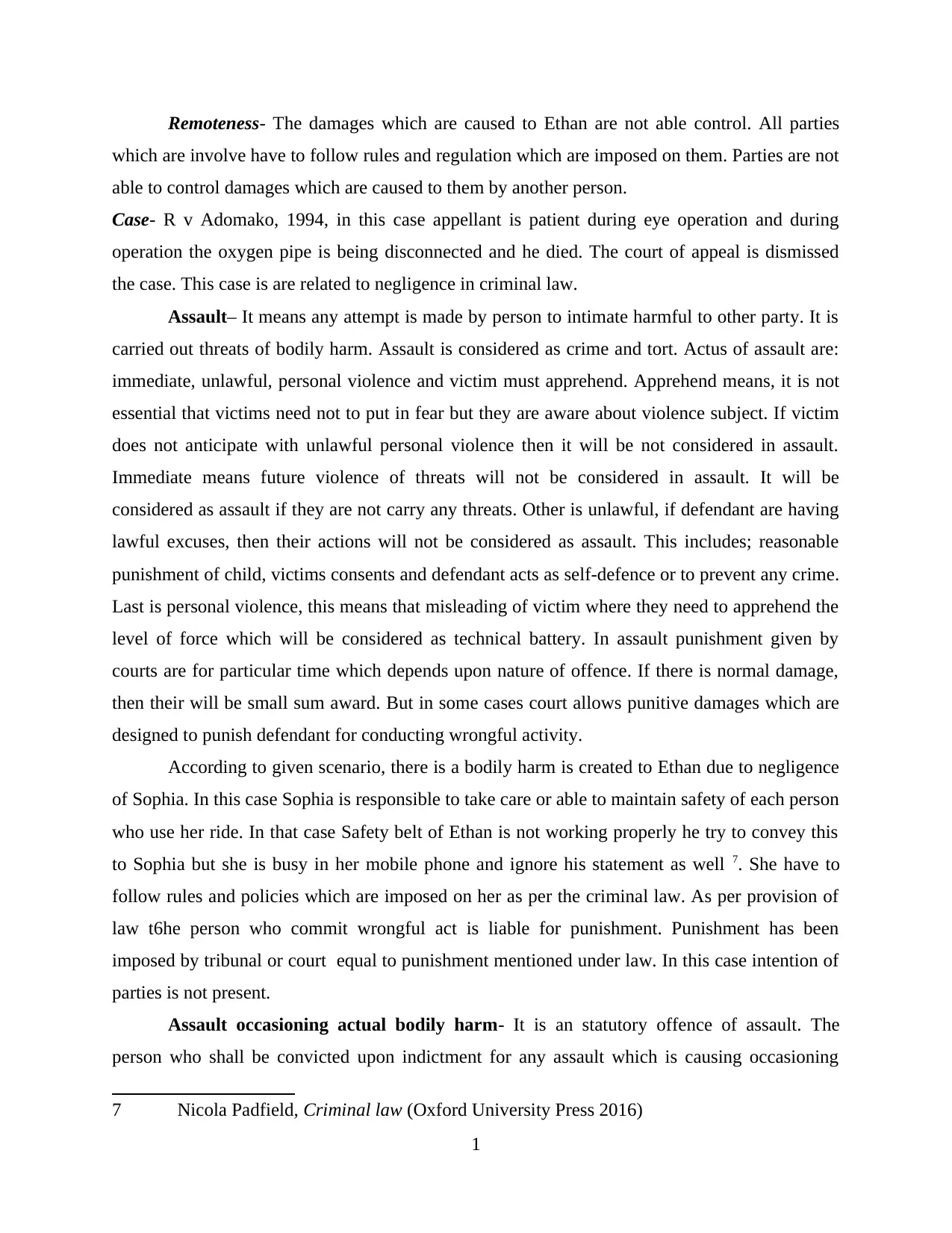
Remoteness- The damages which are caused to Ethan are not able control. All parties
which are involve have to follow rules and regulation which are imposed on them. Parties are not
able to control damages which are caused to them by another person.
Case- R v Adomako, 1994, in this case appellant is patient during eye operation and during
operation the oxygen pipe is being disconnected and he died. The court of appeal is dismissed
the case. This case is are related to negligence in criminal law.
Assault– It means any attempt is made by person to intimate harmful to other party. It is
carried out threats of bodily harm. Assault is considered as crime and tort. Actus of assault are:
immediate, unlawful, personal violence and victim must apprehend. Apprehend means, it is not
essential that victims need not to put in fear but they are aware about violence subject. If victim
does not anticipate with unlawful personal violence then it will be not considered in assault.
Immediate means future violence of threats will not be considered in assault. It will be
considered as assault if they are not carry any threats. Other is unlawful, if defendant are having
lawful excuses, then their actions will not be considered as assault. This includes; reasonable
punishment of child, victims consents and defendant acts as self-defence or to prevent any crime.
Last is personal violence, this means that misleading of victim where they need to apprehend the
level of force which will be considered as technical battery. In assault punishment given by
courts are for particular time which depends upon nature of offence. If there is normal damage,
then their will be small sum award. But in some cases court allows punitive damages which are
designed to punish defendant for conducting wrongful activity.
According to given scenario, there is a bodily harm is created to Ethan due to negligence
of Sophia. In this case Sophia is responsible to take care or able to maintain safety of each person
who use her ride. In that case Safety belt of Ethan is not working properly he try to convey this
to Sophia but she is busy in her mobile phone and ignore his statement as well 7. She have to
follow rules and policies which are imposed on her as per the criminal law. As per provision of
law t6he person who commit wrongful act is liable for punishment. Punishment has been
imposed by tribunal or court equal to punishment mentioned under law. In this case intention of
parties is not present.
Assault occasioning actual bodily harm- It is an statutory offence of assault. The
person who shall be convicted upon indictment for any assault which is causing occasioning
7 Nicola Padfield, Criminal law (Oxford University Press 2016)
1
which are involve have to follow rules and regulation which are imposed on them. Parties are not
able to control damages which are caused to them by another person.
Case- R v Adomako, 1994, in this case appellant is patient during eye operation and during
operation the oxygen pipe is being disconnected and he died. The court of appeal is dismissed
the case. This case is are related to negligence in criminal law.
Assault– It means any attempt is made by person to intimate harmful to other party. It is
carried out threats of bodily harm. Assault is considered as crime and tort. Actus of assault are:
immediate, unlawful, personal violence and victim must apprehend. Apprehend means, it is not
essential that victims need not to put in fear but they are aware about violence subject. If victim
does not anticipate with unlawful personal violence then it will be not considered in assault.
Immediate means future violence of threats will not be considered in assault. It will be
considered as assault if they are not carry any threats. Other is unlawful, if defendant are having
lawful excuses, then their actions will not be considered as assault. This includes; reasonable
punishment of child, victims consents and defendant acts as self-defence or to prevent any crime.
Last is personal violence, this means that misleading of victim where they need to apprehend the
level of force which will be considered as technical battery. In assault punishment given by
courts are for particular time which depends upon nature of offence. If there is normal damage,
then their will be small sum award. But in some cases court allows punitive damages which are
designed to punish defendant for conducting wrongful activity.
According to given scenario, there is a bodily harm is created to Ethan due to negligence
of Sophia. In this case Sophia is responsible to take care or able to maintain safety of each person
who use her ride. In that case Safety belt of Ethan is not working properly he try to convey this
to Sophia but she is busy in her mobile phone and ignore his statement as well 7. She have to
follow rules and policies which are imposed on her as per the criminal law. As per provision of
law t6he person who commit wrongful act is liable for punishment. Punishment has been
imposed by tribunal or court equal to punishment mentioned under law. In this case intention of
parties is not present.
Assault occasioning actual bodily harm- It is an statutory offence of assault. The
person who shall be convicted upon indictment for any assault which is causing occasioning
7 Nicola Padfield, Criminal law (Oxford University Press 2016)
1
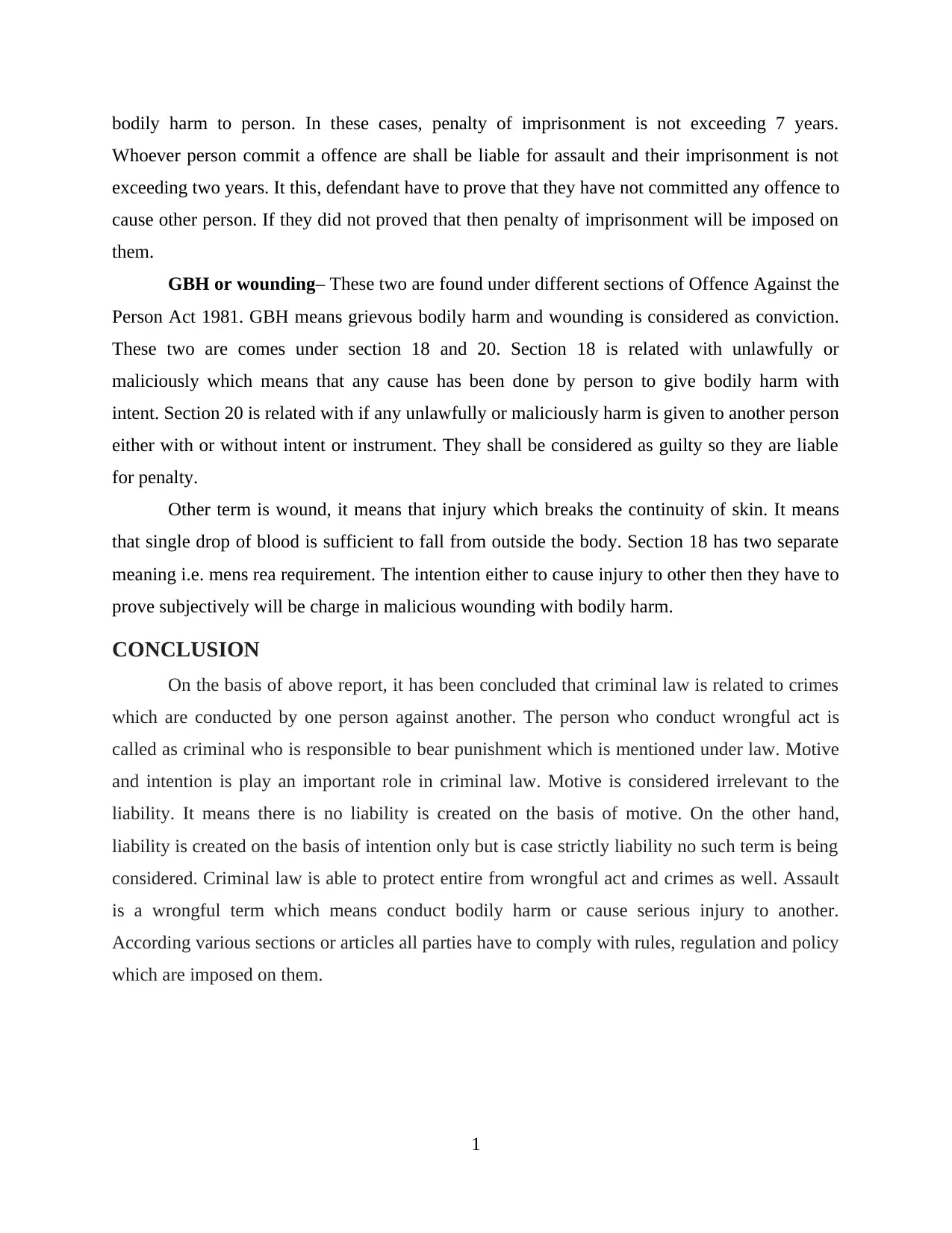
bodily harm to person. In these cases, penalty of imprisonment is not exceeding 7 years.
Whoever person commit a offence are shall be liable for assault and their imprisonment is not
exceeding two years. It this, defendant have to prove that they have not committed any offence to
cause other person. If they did not proved that then penalty of imprisonment will be imposed on
them.
GBH or wounding– These two are found under different sections of Offence Against the
Person Act 1981. GBH means grievous bodily harm and wounding is considered as conviction.
These two are comes under section 18 and 20. Section 18 is related with unlawfully or
maliciously which means that any cause has been done by person to give bodily harm with
intent. Section 20 is related with if any unlawfully or maliciously harm is given to another person
either with or without intent or instrument. They shall be considered as guilty so they are liable
for penalty.
Other term is wound, it means that injury which breaks the continuity of skin. It means
that single drop of blood is sufficient to fall from outside the body. Section 18 has two separate
meaning i.e. mens rea requirement. The intention either to cause injury to other then they have to
prove subjectively will be charge in malicious wounding with bodily harm.
CONCLUSION
On the basis of above report, it has been concluded that criminal law is related to crimes
which are conducted by one person against another. The person who conduct wrongful act is
called as criminal who is responsible to bear punishment which is mentioned under law. Motive
and intention is play an important role in criminal law. Motive is considered irrelevant to the
liability. It means there is no liability is created on the basis of motive. On the other hand,
liability is created on the basis of intention only but is case strictly liability no such term is being
considered. Criminal law is able to protect entire from wrongful act and crimes as well. Assault
is a wrongful term which means conduct bodily harm or cause serious injury to another.
According various sections or articles all parties have to comply with rules, regulation and policy
which are imposed on them.
1
Whoever person commit a offence are shall be liable for assault and their imprisonment is not
exceeding two years. It this, defendant have to prove that they have not committed any offence to
cause other person. If they did not proved that then penalty of imprisonment will be imposed on
them.
GBH or wounding– These two are found under different sections of Offence Against the
Person Act 1981. GBH means grievous bodily harm and wounding is considered as conviction.
These two are comes under section 18 and 20. Section 18 is related with unlawfully or
maliciously which means that any cause has been done by person to give bodily harm with
intent. Section 20 is related with if any unlawfully or maliciously harm is given to another person
either with or without intent or instrument. They shall be considered as guilty so they are liable
for penalty.
Other term is wound, it means that injury which breaks the continuity of skin. It means
that single drop of blood is sufficient to fall from outside the body. Section 18 has two separate
meaning i.e. mens rea requirement. The intention either to cause injury to other then they have to
prove subjectively will be charge in malicious wounding with bodily harm.
CONCLUSION
On the basis of above report, it has been concluded that criminal law is related to crimes
which are conducted by one person against another. The person who conduct wrongful act is
called as criminal who is responsible to bear punishment which is mentioned under law. Motive
and intention is play an important role in criminal law. Motive is considered irrelevant to the
liability. It means there is no liability is created on the basis of motive. On the other hand,
liability is created on the basis of intention only but is case strictly liability no such term is being
considered. Criminal law is able to protect entire from wrongful act and crimes as well. Assault
is a wrongful term which means conduct bodily harm or cause serious injury to another.
According various sections or articles all parties have to comply with rules, regulation and policy
which are imposed on them.
1
⊘ This is a preview!⊘
Do you want full access?
Subscribe today to unlock all pages.

Trusted by 1+ million students worldwide
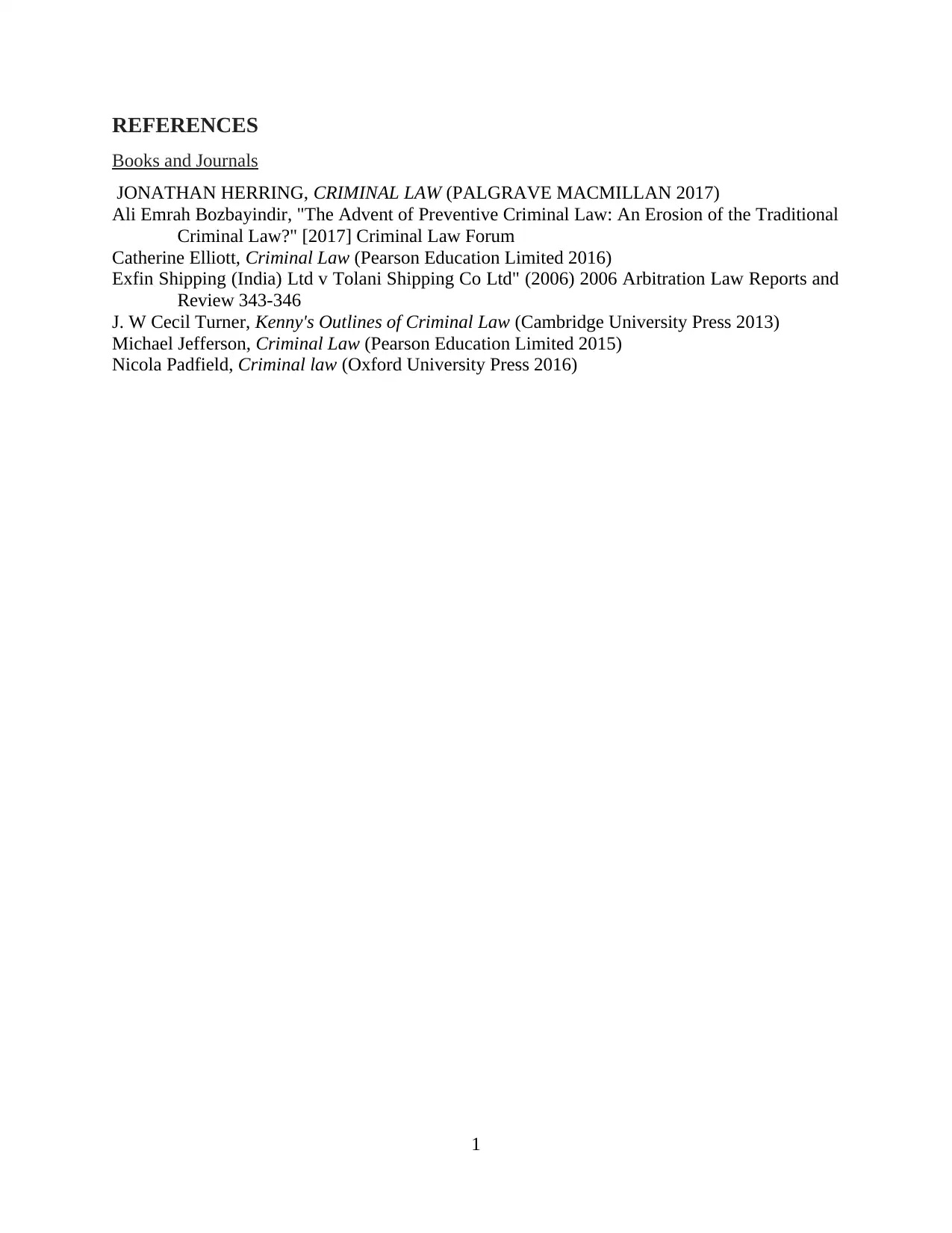
REFERENCES
Books and Journals
JONATHAN HERRING, CRIMINAL LAW (PALGRAVE MACMILLAN 2017)
Ali Emrah Bozbayindir, "The Advent of Preventive Criminal Law: An Erosion of the Traditional
Criminal Law?" [2017] Criminal Law Forum
Catherine Elliott, Criminal Law (Pearson Education Limited 2016)
Exfin Shipping (India) Ltd v Tolani Shipping Co Ltd" (2006) 2006 Arbitration Law Reports and
Review 343-346
J. W Cecil Turner, Kenny's Outlines of Criminal Law (Cambridge University Press 2013)
Michael Jefferson, Criminal Law (Pearson Education Limited 2015)
Nicola Padfield, Criminal law (Oxford University Press 2016)
1
Books and Journals
JONATHAN HERRING, CRIMINAL LAW (PALGRAVE MACMILLAN 2017)
Ali Emrah Bozbayindir, "The Advent of Preventive Criminal Law: An Erosion of the Traditional
Criminal Law?" [2017] Criminal Law Forum
Catherine Elliott, Criminal Law (Pearson Education Limited 2016)
Exfin Shipping (India) Ltd v Tolani Shipping Co Ltd" (2006) 2006 Arbitration Law Reports and
Review 343-346
J. W Cecil Turner, Kenny's Outlines of Criminal Law (Cambridge University Press 2013)
Michael Jefferson, Criminal Law (Pearson Education Limited 2015)
Nicola Padfield, Criminal law (Oxford University Press 2016)
1
1 out of 10
Related Documents
Your All-in-One AI-Powered Toolkit for Academic Success.
+13062052269
info@desklib.com
Available 24*7 on WhatsApp / Email
![[object Object]](/_next/static/media/star-bottom.7253800d.svg)
Unlock your academic potential
Copyright © 2020–2025 A2Z Services. All Rights Reserved. Developed and managed by ZUCOL.





